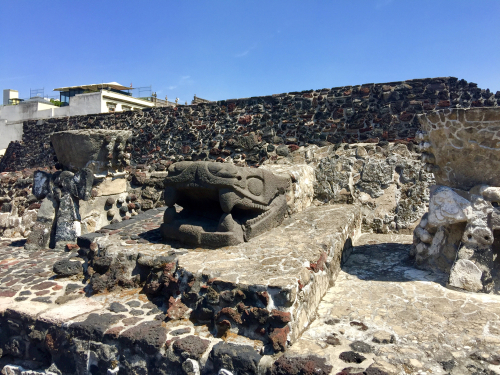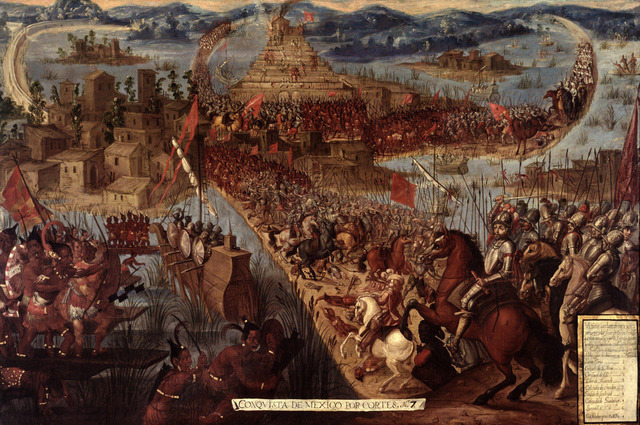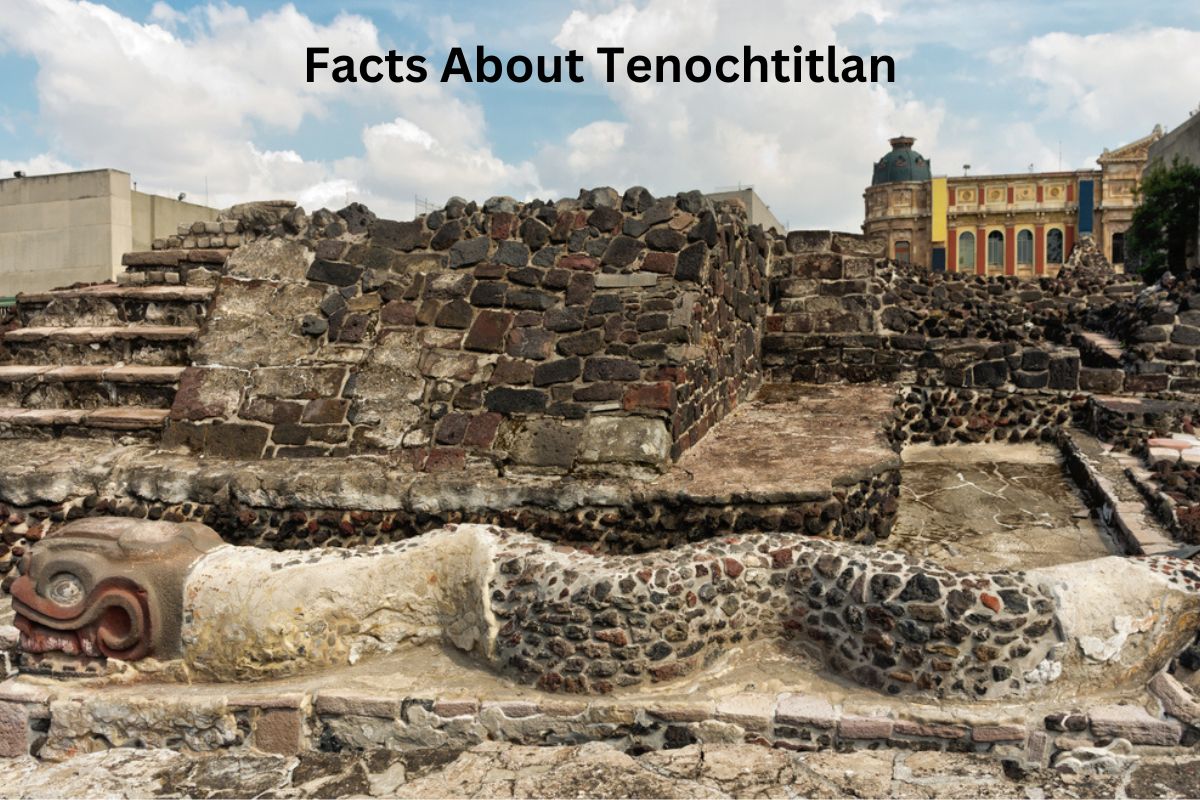In the heart of the Valley of Mexico once stood a magnificent city that captured the awe and wonder of its time – Tenochtitlan. Founded in 1325 by the Mexica people, it rose to become the grand capital of the Aztec Empire.
Situated on an island in Lake Texcoco, Tenochtitlan’s strategic location and advanced engineering made it a thriving metropolis with a bustling population.
The city’s religious significance was epitomized by the Templo Mayor, an impressive pyramid dedicated to the worship of gods Huitzilopochtli and Tlaloc.
However, the fate of this illustrious civilization took a tragic turn with the arrival of the Spanish conquistadors led by Hernán Cortés, ultimately marking the end of the Aztec Empire.
Today, the legacy of Tenochtitlan lives on in the rich history and archaeological discoveries of Mexico City, where the ancient splendor of this once-great capital continues to captivate the world.
Tenochtitlan Facts
1. Capital of the Aztec Empire
Tenochtitlan served as the political, cultural, and religious center of the Aztec Empire. The city was strategically located in the Valley of Mexico, surrounded by Lake Texcoco and other smaller lakes.
Also Read: Aztec Timeline
This central location allowed the Aztecs to establish control over trade routes and expand their influence over neighboring regions.

2. Founded in 1325 on an island in Lake Texcoco
According to Aztec mythology, the Mexica people were instructed by their god Huitzilopochtli to build their capital city where they saw an eagle perched on a cactus, devouring a snake.
Also Read: Mayans Facts
This vision was fulfilled when they encountered a small swampy island in Lake Texcoco, where they decided to establish their city. The island provided natural protection against potential enemies and was a strategic choice for defense.
3. Named after the Aztec god “Tenoch”
The name “Tenochtitlan” is derived from the Aztec deity “Tenoch,” who was highly revered in their religious pantheon. According to Aztec beliefs, Tenoch was considered to be a cultural hero and one of the four divine sons of the god Ometeotl.
The choice of naming their capital after this deity was a testament to the Mexica’s spiritual connection and devotion to their gods, which played a central role in shaping their society and guiding their actions.
4. Impressive engineering with causeways and canals
Tenochtitlan was an engineering marvel of its time, characterized by an elaborate system of causeways and canals that helped manage the city’s water supply and transportation.
The Aztecs constructed a network of causeways, or raised roads, to connect the city to the mainland and other neighboring cities. These causeways allowed easy movement of people and goods, especially during the rainy season when the lake’s water levels rose.
5. Used “chinampas” (floating gardens) for agriculture
One of the most remarkable agricultural innovations developed by the Aztecs was the creation of “chinampas” or floating gardens. The Aztecs built these artificial islands by weaving together bundles of reeds and then piling mud and vegetation on top.
These chinampas were anchored to the lakebed using wooden stakes. The rich and fertile mud from the lake bottom, combined with the ingenious irrigation system, allowed the Aztecs to cultivate crops in the heart of the lake.
This farming technique significantly increased the city’s agricultural productivity, enabling it to sustain its large population.

6. Peak population estimated at 200,000 to 300,000 people
Tenochtitlan was a bustling metropolis with a thriving population. At its height, the city was one of the largest in the world, surpassing many European capitals of the time.
Its impressive infrastructure, advanced agricultural techniques, and well-developed trade routes attracted people from various regions, contributing to its rapid growth.
The population was diverse, including Aztecs, merchants from other city-states, artisans, warriors, and slaves, all living together in a vibrant and dynamic urban center.
7. Templo Mayor was the central temple dedicated to gods Huitzilopochtli and Tlaloc
The Templo Mayor was the most important religious structure in Tenochtitlan and was dedicated to the worship of two major Aztec deities – Huitzilopochtli and Tlaloc. Huitzilopochtli was the god of war, the sun, and the patron deity of the Mexica people.
Tlaloc, on the other hand, was the god of rain, fertility, and agriculture. The temple was a massive pyramid with twin shrines on the top, one for each god.
It was a focal point for religious ceremonies, rituals, and human sacrifices, which the Aztecs believed were necessary to ensure the gods’ favor and maintain the balance of the cosmos.
8. The Great Pyramid at the Templo Mayor was about 60 meters tall
The Templo Mayor’s main pyramid was an awe-inspiring structure, soaring to approximately 60 meters (197 feet) in height. The pyramid was constructed in multiple stages, with each successive ruler adding to its height and splendor.
The Great Pyramid’s massive size, combined with its prominent location in the city center, made it a visible and imposing symbol of the Aztec Empire’s power and religious significance.
9. Human sacrifices were part of Aztec religious practices
The practice of human sacrifice was deeply ingrained in Aztec religious beliefs. They believed that offering human blood and hearts to the gods was necessary to ensure the continuity of the cosmos and the survival of their civilization.
During major religious festivals, captives, and sometimes even volunteers, would be chosen for sacrifice. These individuals would be taken to the top of the Templo Mayor, where a priest would ritually remove their heart, offering it to the gods. The life force believed to be contained in the heart was considered a powerful gift to the deities.
10. Conquered by Hernán Cortés in 1521, leading to the fall of the Aztec Empire
The remarkable civilization of Tenochtitlan faced a tragic end with the arrival of Spanish conquistadors led by Hernán Cortés in 1519.
After a series of encounters and alliances with local indigenous groups who were enemies of the Aztecs, Cortés and his forces laid siege to Tenochtitlan in 1521. The siege was brutal and lasted for months, ultimately resulting in the city’s surrender.
The fall of Tenochtitlan marked the end of the Aztec Empire and the beginning of Spanish rule in Mesoamerica. The Spanish proceeded to dismantle much of the city and built Mexico City on its ruins, incorporating some of the stones from the Templo Mayor into their new constructions.
The history of Tenochtitlan, with its religious significance, grandeur, and ultimate downfall, remains a captivating tale of a once-mighty civilization that significantly shaped the history and culture of modern-day Mexico. The ruins of the Templo Mayor, unearthed in the heart of Mexico City, stand as a testament to the achievements and legacy of the Aztec Empire.
